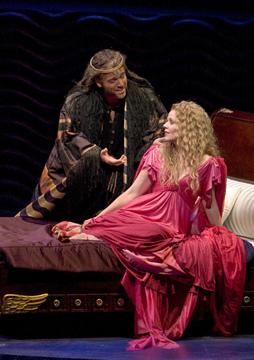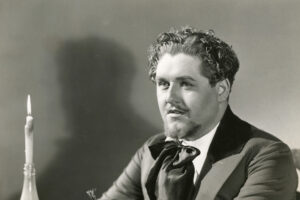
Our Own Gualtier Maldè reports:
Not every opera has to be a masterpiece. I couldn’t subsist on a steady diet of Tristan und Isolde, Die Zauberfloete, Fidelio, plus Otello, Falstaff et al. Frankly the occasional light comic bonbon or trashy but fun melodramatic tunefest makes a nice palate cleanser. I am talking Adriana Lecouvreur, La Gioconda, Mignon – you know – the operas critics love to hate.Â
I very much wanted Thaïs to be a guilty pleasure like La Gioconda or Adriana but alas, the opening night performance of the Met’s new production dashed my hopes. Thaïs is an act of diva worship, purely a vehicle for a glamorous soprano to put in as much vocal and dramatic bling-bling into her performance while leaving out of her costumes as much as modesty will allow. The opening night on Monday had celebrities like Christine Baranski and Anna Netrebko (with bass-barihunk Erwin Schrott in tow) and the rest of the audience primed to give Renée Fleming a sternstunde event. It turned out to be a somewhat lukewarm evening.Â
Some of the problems stem from the piece itself. The religious satire has been removed from the original novella by Anatole France leaving a straightforward but flimsy saga of sinner to saint. The story begs for Lana Turner in a harem girl outfit, a Dmitri Tiomkin score and widescreen technicolor. The opera really is kind of trashy – the operatic equivalent of those bad biblical epics Hollywood did in the 1940’s and 50’s like Turner in The Prodigal or Rita Hayworth as Salome. Not quite Maria Montez in Cobra Woman but in a few places you are not far off. Late 19th century audiences thrilled to the idea of religion mixed with sensuality and sin. Modern audiences after decades of fallen evangelists and right-wing Republican moralists are less titillated by this. This theme is prefigured in the Saint-Sulpice scene of Massenet’s true masterpiece Manon – but the music in Thaïs seldom reaches that level. Â

Ken Howard / Metropolitan Opera
The religious music is rather dull and workaday – Massenet seems to be more interested in sensuality and decadence. There is a phony religiosity – kind of like those portraits that purported to show scenes from the bible as an excuse to paint lots of nude women. You know – the Rape of the Sabine Women et al. The pagan decadence sections of the score have a kind of perfumed banality resembling ballet or salon music sprinkled over with the typical French “exotic” “oriental” touches with triangle, timpani, harp and drum that generically fit locations as far-flung as Egypt, India, Morocco, Arabia, Goa and the South Seas islands.Â
The first act, especially the first scene in the desert, is devoid of much musical substance (Athanael’s big aria excepted) and merely introduces characters and situations that are recapitulated more interestingly later. Most of the fashionable Parisian audience would skip the first act and come late, so this may have been intentional on Massenet’s part. Outside of Thaïs’s big numbers and a few interludes like the famous “Meditation” and a few effective dramatic moments for Athanael, the score is full of longeurs and second-hand inspiration. Anyway, several companions derided the opera as kitsch and called it “meritricious” and flimsy.  It needs vocal splendour, an impassioned conductor, a lavish physical production and lots of commitment and style to put it over. The Met did a middling job
The borrowed production from Lyric Opera of Chicago by John Cox is functional spectacle on a budget where the tacky Cecil B. DeMille splendor of Zeffirelli is needed. The original designer Paul Brown has had his name removed from the production though his sets and many of his costumes are still on view. Painted curving flats and staircase in metallic turquoise and gold suggest the palaces of Alexandria and rippled yellow platforms suggest the deserts of Egypt. The costumes are a mishmash of periods from 19th century evening wear to kaftans, harem pants and dreadlocks. Costumes designers avoid putting middle-aged male opera singers in togas, so Nicias wears a dressing gown over a tuxedo with a fez and Thomas Hampson staggers about in long sackcloth or kaftans.Â
Renée has custom creations by Christian Lacroix that are stylish, sometimes ornate, well-integrated into Paul Brown’s design and rather modest. I suspect that Mary Garden and I know that Carol Neblett showed more skin. Renée in her courtesan persona wears long evening gowns with fitted, low-cut bodices in gold and fuschia chiffon. We get lots of decolleté but no bare-midriff (one gown has a flesh colored body suit beneath the jeweled brassiere) and all are floor-length so we don’t get to see her legs. Her hermit’s mitre is cinched in at the waist, off-the-shoulder with artful distressing by the clever Parisian couturier. She greets immortality and possible sainthood is crushed white silk. Fleming has a costume change for every scene in true diva fashion.
The diva clearly has worked on her body and face so that she looks more than a decade younger than her actual years. The opera glasses show a chiseled jawline, smooth skin and a wasp-waisted, shapely but slim figure. Definitely she is glamorous as befits her conception of Thaïs as not only a courtesan but a theatrical celebrity and star.Â
However, the voice on opening night was lacking in the extra juice and easy top that would match her lovely appearance. The tone is still beguiling and the fussy mannerisms suit the fin de siecle decadence of the music. However, the tone was somewhat light and lacked reserves of power for dramatic passages. The high C’s sounded pushed and wavery, the D’s at the end of the mirror aria and in the final duet were tenuous and barely held. The mirror aria “Dis-moi que je suis belle” was taken at a dirge-like slow tempo and was all melancholy and self-pitying without the surging desperation that would propel the high climaxes excitingly.Â
On the other hand, the more intimate “L’Amour est une vertu rare” was nicely phrased and tonally lovely. The score hits many of the most attractive areas of her voice and suits her style but according to a reliable source, Fleming was much better vocally in Chicago in 2002. On the second evening (December 11th) the top was more responsive and reliable and she got a more enthusiastic audience response. Her acting is sympathetic and elegant but more passion is needed, Fleming’s approach is rather soft-focus and ladylike. Over the top diva projection is more effective than tasteful sincerity in putting over a piece like this.
More dramatic energy was provided by Thomas Hampson as Athanael who had declamatory force in his singing and emotional commitment in his acting that made up for some blustery, hectoring tones. However, his rather dry Anglo-Saxon timbre suits French music better than it does Verdi or Italian bel canto. Michael Schade as Nicias was serviceable but his singing lacked elegance and style – he attempted some soft high notes but really didn’t make much of the role. Alain Vernhes in the stand and sing role of Palemon showed real gallic style and authority in his Met debut – he reminded me of prime Bacquier. Leah Partridge showed up in a Merry Widow outfit as the Charmeuse and ended her vocalise with a Marlene Dietrich sapphic smooch with the belly dancer soloist.Â
Another wet blanket was the lifeless conducting of Jesus Lopez-Cobos who got competent playing from the orchestra that lacked emotional passion and dramatic propulsion. Yves Abel does much better on the Decca recording with Fleming and Hampson. It is a shame that Marcello Viotti wasn’t on hand for this and anything else he would have wanted to conduct.
The second evening showed definite improvement over the opening night (intrusive scene change noises behind the curtain during the “Meditation” were largely eliminated last night). Hopefully this will settle in to a satisfying if less than inspiring show. I don’t know that it is a work that I will want to revisit any time soon however. Perhaps Netrebko was inspired by her viewing of the opening night show to consider taking on this cousin to the Manon she has already made a signature role. She has all the allure, high notes and vocal capital necessary with the dramatic energy dash to put it over. — Gualtier Maldè
Reach your audience through parterre box!
parterre box, “the most essential blog in opera” (New York Times), is now booking display and sponsored content advertising for the 2023-2024 season. Join Carnegie Hall, Lincoln Center, Warner Classics and many others in reaching your target audience through parterre box.
parterre box, “the most essential blog in opera” (New York Times), is now booking display and sponsored content advertising for the 2023-2024 season. Join Carnegie Hall, Lincoln Center, Warner Classics and many others in reaching your target audience through parterre box.
-
Topics: 192, anna anna anna, barihunk, bel canto, camp, critic, diva, frocks, gualtier malde, guest critic, la scoopenda, new york times, our own, the Met
Latest on Parterre
Win tickets to Piotr Beczala at Carnegie Hall!
pb—with our friends at Carnegie Hall—is giving away two tickets to PB’s December concert. Enter now!
pb—with our friends at Carnegie Hall—is giving away two tickets to PB’s December concert. Enter now!
Win tickets to Piotr Beczala at Carnegie Hall!
pb—with our friends at Carnegie Hall—is giving away two tickets to PB’s December concert. Enter now!
pb—with our friends at Carnegie Hall—is giving away two tickets to PB’s December concert. Enter now!
parterre in your box?
Get our free weekly newsletter delivered to your email.


























Comments